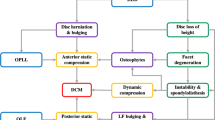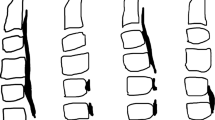Abstract
Introduction
Alström syndrome (AS) is a rare autosomal recessive genetic disorder with multisystemic involvement characterised by early blindness, hearing loss, obesity, insulin resistance, diabetes mellitus, dilated cardiomyopathy, and progressive hepatic and renal dysfunction. The clinical features, time of onset and severity can vary greatly among different patients. Many of the phenotypes are often not present in infancy but develop throughout childhood and adolescence. Recessively inherited mutations in ALMS1 gene are considered to be responsible for the causation of AS. Musculoskeletal manifestations including scoliosis and kyphosis have been previously described.
Case report
Here, we present a patient with AS who presented with cervical myelopathy due to extensive flowing ossification of the anterior and posterior longitudinal ligaments of the cervical spine resulting in cervical spinal cord compression. The presence of an auto-fused spine in an acceptable sagittal alignment, in the background of a constellation of medical comorbidities, which necessitated a less morbid surgical approach, favored a posterior cervical laminectomy decompression in this patient. Postoperatively, the patient showed significant neurological recovery with improved function. Follow-up MRI showed substantial enlargement of the spinal canal with improved space available for the spinal cord. The rarity of the syndrome, cervical myelopathy due to ossified posterior longitudinal ligament as a disease phenotype and the treatment considerations for performing a posterior cervical decompression have been discussed in this Grand Rounds’ case presentation.




Similar content being viewed by others
References
Marshall JD, Beck S, Maffei P, Naggert JK (2007) Alström syndrome. Eur J Hum Genet 15(12):1193–1202
Alstrom CH, Hallgren B, Nilsson LB, Asander H (1959) Retinal degeneration combined with obesity, diabetes mellitus and neurogenous deafness: a specific syndrome (not hitherto described) distinct from the Laurence-Moon-Bardet-Biedl syndrome: a clinical, endocrinological and genetic examination based on a large pedigree. Acta psychiatrica et neurologica Scandinavica 129:1–35
Minton JA, Owen KR, Ricketts CJ, Crabtree N, Shaikh G, Ehtisham S, Porter JR, Carey C, Hodge D, Paisey R, Walker M, Barrett TG (2006) Syndromic obesity and diabetes: changes in body composition with age and mutation analysis of ALMS1 in 12 United Kingdom kindreds with Alstrom syndrome. J Clin Endocrinol Metab 91(8):3110–3116
Marshall JD, Bronson RT, Collin GB, Nordstrom AD, Maffei P, Paisey RB, Carey C, Macdermott S, Russell-Eggitt I, Shea SE, Davis J, Beck S, Shatirishvili G, Mihai CM, Hoeltzenbein M, Pozzan GB, Hopkinson I, Sicolo N, Naggert JK, Nishina PM (2005) New Alstrom syndrome phenotypes based on the evaluation of 182 cases. Arch Intern Med 165(6):675–683
Marshall JD, Ludman MD, Shea SE, Salisbury SR, Willi SM, LaRoche RG, Nishina PM (1997) Genealogy, natural history, and phenotype of Alstrom syndrome in a large Acadian kindred and three additional families. Am J Med Genet A 73(2):150–161
Joy T, Cao H, Black G, Malik R, Charlton-Menys V, Hegele RA, Durrington PN (2007) Alstrom syndrome (OMIM 203800): a case report and literature review. Orphanet J Rare Dis 2(49):1–10
Awazu M, Tanaka T, Sato S, Anzo M, Higuchi M, Yamazaki K, Matsuo N (1997) Hepatic dysfunction in two sibs with Alstrom syndrome: case report and review of the literature. Am J Med Genet A 69:13–16
Matsuoka T, Yamaura I, Kurosa Y, Nakai O, Shindo S, Shinomiya K (2001) Long-term results of the anterior floating method for cervical myelopathy caused by ossification of the posterior longitudinal ligament. Spine 26:241–248
Resnick D, Niwayama G (eds) (1994) Diagnosis of bone and joint disorders: with emphasis on articular abnormalities. WB Saunders, London
Inamasu J, Guiot BH, Sachs DC (2006) Ossification of the posterior longitudinal ligament: an update on its biology, epidemiology, and natural history. Neurosurgery 58:1027–1039
Ehara S, Shimamura T, Nakamura R, Yamazaki K (1998) Paravertebral ligamentous ossification: DISH, OPLL and OLF. Eur J Radiol 27:196–205
McAfee PC, Regan JJ, Bohlman HH (1987) Cervical cord compression from ossification of the posterior longitudinal ligament in non-orientals. J Bone Joint Surg Br 69:569–575
Chen Y, Guo Y, Lu X, Chen D, Song D, Shi J, Yuan W (2011) Surgical strategy for multilevel severe ossification of posterior longitudinal ligament in the cervical spine. J Spinal Disord Tech 24(1):24–30
Albert TJ, Vacarro A (1998) Postlaminectomy kyphosis. Spine 23:2738–2745
Jain SK, Salunke PS, Vyas KH, Behari SS, Banerji D, Jain VK (2005) Multisegmental cervical ossification of the posterior longitudinal ligament: anterior vs posterior approach. Neurol India 53:283–286
Hida K, Iwasaki Y, Kohanagi I, Abe H (1997) Bone window computed tomography for detection of dural defect associated with cervical ossified posterior longitudinal ligament. Neurol Med Chir (Tokyo) 37:173–176
Smith ZA, Buchanan CC, Raphael D, Khoo LT (2011) Ossification of the posterior longitudinal ligament: pathogenesis, management, and current surgical approaches—a review. Neurosurg Focus 30(3):E10, 1–10
Gwinn DE, Iannotti CA, Benzel EC, Steinmetz MP (2009) Effective lordosis: analysis of sagittal spinal canal alignment in cervical spondylotic myelopathy. J Neurosurg Spine 11:667–672
Fujiyoshi T, Yamazaki M, Kawabe J, Endo T, Furuya T, Koda M, Okawa A, Takahashi K, Konishi H (2008) A new concept for making decisions regarding the surgical approach for cervical ossification of the posterior longitudinal ligament: the K-line. Spine 33:E990–E993
Baba H, Furusawa N, Chen Q, Imura S (1995) Cervical laminoplasty in patients with ossification of the posterior longitudinal ligaments. Paraplegia 33:25–29
Goto S, Kita T (1995) Long-term follow-up evaluation of surgery for ossification of the posterior longitudinal ligament. Spine 20:2247–2256
Conflict of interest
None.
Author information
Authors and Affiliations
Corresponding author
Rights and permissions
About this article
Cite this article
Kanna, R.M., Gradil, D. & Boszczyk, B.M. Management of cervical myelopathy due to ossification of posterior longitudinal ligament in a patient with Alström syndrome. Eur Spine J 21, 2418–2424 (2012). https://doi.org/10.1007/s00586-012-2305-0
Received:
Accepted:
Published:
Issue Date:
DOI: https://doi.org/10.1007/s00586-012-2305-0




